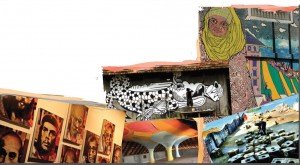 Kochi opened its window to the world of contemporary art and colours on the 12.12.12 with the commencement of the first ever Biennale in India.
Kochi opened its window to the world of contemporary art and colours on the 12.12.12 with the commencement of the first ever Biennale in India.
This is the largest Contemporary art festival in the country to be held every other year. Collaborating closely with the Muziris Heritage Project, the Biennale celebrates Kerala’s rich heritage in arts. World renowned contemporary artists are participating in this festival which is expected to give a grand boost to the ongoing tourism season as well.
Out of the total 80 artists participating, 40 are from abroad, 22 from Kerala and the rest from other parts of the country, Fort Kochi is abuzz with activity.
Even the venues selected have their relevance in the culture of the state. Durbar Hall will be one such for all the paintings and sculptures. Built in the 1850s, it was the royal court of the rulers of Kochi.
Another is David Hall, built around 1695 by the Dutch East India Company and was the office of the Dutch Governor-General. The hall takes the name of David Koder, a Jewish businessman who later resided there with his family. Cochin Club by its side was an exclusive British Gentlemen’s Club, and will have biennale art and sculpture installations.
Aspinwall House set up during the 1850s by the English trader John H. Aspinwall is another important venue for Biennale. Yet another venue Pepper House was a warehouse by the waterfront.
The Kochi-Muziris Biennale seeks to invoke the historic cosmopolitan legacy of Kochi and its predecessor, the ancient port of Muziris. Muziris is thought to have been involved in the spice trade as early as the third century B.C., trading with Romans, Greeks, Chinese, Jews and Arabs. It is said to have been wiped out in 1341, when the Periyar River flooded, after which the town of Cochin, 20 miles to the south, rose to commercial prominence.
The exhibition is set in spaces across Kochi, Muziris and surrounding islands. There are shows in existing galleries and halls, and site-specific installations in public spaces, heritage buildings and neglected structures.
Indian and international artists are exhibiting artworks across a variety of mediums including film, installation, painting, sculpture, new media and performance art.
Alongside the exhibition the Biennale offers a rich and thoughtful schedule of talks, seminars, screenings, music, workshops and educational activities for school children and students of all ages.
For India, the event is a huge step forward with regard to heritage management. Surrounding structures have been given a facelift, and art has been freed from the bondage of galleries and museums.
The country’s first ever Biennale is expected to attract more than 5 lakh visitors from across the globe. Nearly 80 artists from 35 countries are taking part in this art festival.
The three-month-long biennale, will be an extravaganza of art and culture with a nod to the mystical, the wrought-iron gates of Aspinwall House, a sea-facing colonial-era spice house that is one of the main venues, was thrown open to the public.